Whenever you write content to promote your business copywriting techniques keep your message clear and compelling.
This even includes “behind the scenes” content such as emailing potential affiliates, partners and clients.
In business, persuasive writing is always useful.
However, as part of your Fast Track to Copywriting, in this article, I”m going to focus on the key business areas that benefit the most from copywriting.
Your Website Content

If your website only lets prospects know your opening hours, location and prices, you’re missing an opportunity to attract clients.
Coupled with a content marketing plan, your web content can increase the number of ideal clients not just finding your business, but actively seeking you out.
Here are a few top tips for writing compelling website content:
- Write copy based on your target market profile. A targeted message attracts your ideal customers and filters out unsuitable prospects (no more time-wasting enquiries)
- A clear welcome message lets visitors know WHAT you do in your business (If they can’t work it out in seconds, they’ll go elsewhere)
- Create a compelling business story that encourages people to share what you do
- Provide clear calls to action Let your visitor know if they should call you, sign up to your newsletter or check out other pages on your website. Don’t assume they will know what to do.
Your Brochure or Leaflets

Any brochure you use to market your business offline or online is a sales tool. And as Judith Charles, president of her own retail advertising agency, famously said:
“A copywriter is a salesperson behind a typewriter” – Judith Charles Tweet This for Kudos
Which means copywriting is a perfect fit for sales materials like brochures.
Even if you only give out brochures to customers after a winning sales pitch, it’s your brochure that’s left to close the deal when you’re no longer there.
That’s why copywriting is used in brochures so that:
- Your customer wants to read it and keep it, not put it under wobbly table legs
- It is shared by your customer to colleagues or potential prospects
- It contains all the details needed for your prospect to make a buying decision or…
- It encourages the reader to call, get in touch or fill out an order form
- It can be tracked so that you can measure marketing spend against actual results
Printed brochures and leaflets can be costly.
Strong copywriting makes sure that money isn’t wasted.
Your Sales Pages
If you’re unfamiliar with the concept of sales pages or sales letters, they are web pages or mailed letters that make a direct sales offer to a potential customer.
They need to have all the information to let prospects evaluate whether the product on offer is right for them, and if it is right, the sales page then has to encourage them to purchase it or contact a sales team as soon as possible.
Sales pages are where you will find just about every copywriting tool and technique used to sell benefits, describe features, provide social proof and give the reader confidence that the business and product can be trusted to deliver on the promise in front of them.
The Email Newsletter – How to Win “The Hidden Sales Cycle”

Every business should have an email newsletter.
When people first discover your business, it won’t always be the right time for them to buy. Hoping that they will come back when they do want you offer is taking a risk.
If you do not keep in touch with prospects your competitors will.
Even if they’re not buying yet, they may sign up to a newsletter that gives them free information to help with the problem on their mind.
Because of the Internet, instead of talking to sales reps, more consumers are doing their own research about products by gathering content from forums, websites and reports.
It’s what’s called:
“The Hidden Sales Cycle.”
Customers are considering their buying options long before they discuss a purchase with a company. That means the sales cycle begins long before a customer calls your office or asks for product information.
Your email newsletter is a way of keeping in touch with them during this period and is influential in making sales.
It’s more than keeping in touch. If you use copywriting to provide valuable information in your email newsletter you can:
- Position your business as a critical resource
- Build the “like, know and trust” factor to give prospects the confidence needed to buy from you
- Create compelling “stepping stone” offers providing a low-investment option to try your service. (Customers are more likely to buy from a business they know. Making them a customer sooner puts you ahead of the curve.)
- Increase response and engagement with content and encourage content sharing.
An email newsletter coupled with compelling copywriting gives your business a killer advantage for attracting and keeping prospects currently within the hidden sales cycle.
Your Blog
Similar to the email newsletter, you don’t have to be constantly selling on your business blog (in fact, you shouldn’t).
And even though copywriting is persuasive writing, it doesn’t mean you’re persuading people to buy all the time.
Instead you may want to:
- Raise awareness that your business exists
- Attract a community of people who would enjoy being customers
- Build your email newsletter list from blog readers
As a result, your blog is more than information about what your business is doing.
It’s a sophisticated “under the radar” marketing medium.
So how can you use copywriting skills in your blog to build a crowd of customers and fans?
- Write attention-stealing headlines that pull your target market to your content
- Write compelling content that has people reading every single line
- Use subheadings to get the attention of even the most casual “scanner”
- Raise awareness of the business brand by persuading readers to share content
- Improve SEO results by earning links back to popular content
- Use strategic calls to action to convert readers into subscribers and buyers
If you are blogging to support your business model, copywriting is an essential skill for you to create content that builds awareness, community and revenue.
Hopefully this article gives you a brief overview of where you can use copywriting in your business.
If you want more specific (and quick) copywriting tips, don’t forget to sign up to Fast Copy Fridays to receive a brief copywriting action point directly from my desk to your inbox.
[signup-form id=”9948″]
